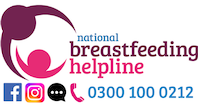This information can also be viewed as a PDF by clicking here.
The information provided is taken from various reference sources. It is provided as a guideline. No responsibility can be taken by the author or the Breastfeeding Network for the way in which the information is used. Clinical decisions remain the responsibility of medical and breastfeeding practitioners. The data presented here is intended to provide some immediate information but cannot replace input from professionals.
The first sign of stomach bug/norovirus is usually a sudden feeling of nausea followed by forceful vomiting and profuse watery diarrhoea. You may also have a raised temperature (over 38C/100.4F), headache and feel generally achy. Most people make a full recovery within a couple of days but it is very unpleasant whilst it lasts.
Treatment
- Drink plenty of water to avoid dehydration – you may only be able to manage a sip at a time whilst the vomiting phase lasts.
- Take paracetamol to reduce your temperature and to relieve any aches and pains.
- Stay at home whilst you have symptoms and for 3 days after because norovirus is contagious.
- Telephone your GP to seek advice if your symptoms last longer than a few days or if you already have a serious illness.
- Wash your hands frequently to prevent the spread of the illness as much as possible. If you feel able you should continue to breastfeed your baby in order to pass on antibodies and protect the baby from developing symptoms (less common in exclusively breastfed babies). You may need another adult to care for the baby between feeds. Even if you have not eaten for several days, you will still make milk for your baby, your breasts may feel softer so you may notice your baby asking to feed more often. Your milk supply will increase again as soon as you start to feel better.
Medication
Some people are prescribed (or buy) prochlorperazine (Buccastem ®, Stemetil ®) tablets to relieve the nausea and vomiting, loperamide (Imodium®) to reduce the symptoms of diarrhoea and rehydrating sachets (Dioralyte ®) to prevent dehydration. These drugs are suitable to take and carry on breastfeeding as normal.
Preventing the spread of the virus
- Wash your hands frequently and thoroughly with soap and water, particularly after using the toilet and before preparing food. Liquid soap is less likely to spread the virus than a bar of soap. Alcohol hand gels do not seem to be effective protection against norovirus.
- Do not share towels and flannels.
- Disinfect any surfaces or objects that could be contaminated with the virus. It is best to use a bleach-based household cleaner.
- Wash any clothing or bedding that could have become contaminated. Wash the items separately and on a hot wash to ensure that the virus is killed.
Bibliography
- Hale T Medications and Mothers Milk
- Jones W Breastfeeding and Medication Routledge 2018
- Lactmed Database; http://toxnet.nlm.nih.gov/cgi-bin/sis/htmlgen?LACT
- NHS Choices Norovirus www.nhs.uk/Conditions/Norovirus/
- Public Health England Norovirus: guidance, data and analysis www.hpa.org.uk/Publications/InfectiousDiseases/GastrointestinalOutbreaksAndIllnessReports/1111noroguidance/
Further Information; Information sheet Diarrhoea and Breastfeeding on the website bfn.local
©Dr Wendy Jones MBE, MRPharmS and the Breastfeeding Network Sept 2019

